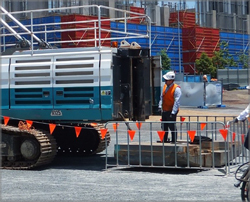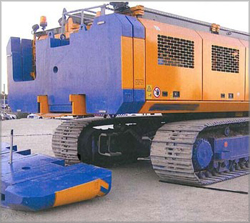Counterweights on mobile plant
Issued: 16 September 2009
Updated: 3 August 2018
Purpose
The purpose of this safety alert is to:
- inform workers about the hazard of falling counterweights when fitting or removing them on mobile plant
- provide guidance on design, fitting, work system and training issues to reduce the risk of anyone being injured or killed by falling counterweights on mobile plant during their fitting or removal.
Background
On 8 January 2016 a 13.4 tonne counterweight fell off the back of a mobile piling rig that was being assembled on a construction site in Brisbane. Of the two workers in the vicinity, one was injured and the other narrowly missed being injured when the counterweight fell.
In 2009, a worker was killed when a 10.5 tonne counterweight fell from the back of a mobile drilling rig. An attempt was being made to remove the counterweight as the plant was being prepared for transport.
Although the design of the counterweight system differed between the two incidents, in both cases the counterweight was able to fall backwards and the partially installed bolts failed.
Photograph 1 shows a view of the piling rig in the 2016 incident and Photograph 2 shows the drilling rig involved in the 2009 incident.
Contributing factors
There can be several reasons why this type of incident occurs, but they may include one or more of the following factors:
- The counterweight and/or counterweight engagement mechanism is not designed to minimise the risk of injuries during rigging and de-rigging operations. One example of this is where the counterweight is mounted on the rear of the plant and can fall down in an arc and onto workers positioned behind the plant when the counterweight locking system is being released.
- The counterweight is not supported or held securely while bolts are being installed. There is no effective system to temporarily secure the counterweight in place prior to the bolts being tightened.
- Workers are required to be in the potential fall zone, behind the counterweight, when installing or removing the counterweight. (i.e. to tighten the bolt(s) that pass through the back of the counterweight).
Action required
Design issues
Counterweights should be designed so a person is never required to be in a position where they could be struck (i.e. not under the counterweight, behind it or in the potential fall zone) if the counterweight becomes detached during fitting or removal.
The use of a crane and lifting gear to stabilise the counterweight while workers are located in the potential fall zone of the counterweight is not acceptable. No one should be in this zone during the activity, due to the high risk. Cranes should only have vertical loads applied to the crane hook.
 Photograph 1: The piling rig from the 2016 incident, where the counterweight fell while being installed. |  Photograph 2: Rear of the drilling rig from the 2009 incident, where the counterweight fell while being removed. |
The following three examples describe reasonable methods of attaching/removing counterweights on mobile plant:
- The counterweight sits in a cradle on the plant and is unable to fall off the plant when all pins and bolts are removed. The counterweight has to be lifted up and out of the cradle for removal.
- The counterweight is provided with pins on the top of the counterweight that can be easily accessed without the need for the worker to be under or behind the counterweight. The counterweight may need to be suspended from another crane so that the pins can be readily removed. In this case the load is stable and cannot fall backwards or sideways, however the worker removing the pins will require a safe system of work for access.
- The counterweights are either fitted or removed by a lifting device on the plant that does not require anyone to be under or behind the counterweight. When the counterweights are lifted into position, a locking device secures the counterweights in place without the need for anyone to be in the potential fall zone.
Safe work procedures
The plant manufacturer should document safe work procedures for the fitting or removal of counterweights.
The procedures should:
- never require a person to be under or behind the counterweight during the fitting or removal of the counterweight
- preferably include step-by-step photographs or diagrams that can be readily understood
- not make general statements that are impractical to comply with.
Workers involved with the fitting or removal of counterweights must be made aware of the safe work procedures prior to starting the activity.
Worker qualifications and experience
Workers involved in the fitting or removal of counterweights on cranes are required to hold a high risk work licence as an intermediate rigger. It is advisable for workers involved in the fitting or removal of counterweights on other mobile plant to also hold this qualification and be experienced in this activity or be adequately trained and supervised by an experienced person until they are considered to be competent.
Further information
Further information may be obtained from the following codes of practice:
- Mobile Crane Code of Practice 2006 (PDF, 1.34 MB)
- Managing the Risks of Plant in the Workplace 2013 (PDF, 1.57 MB)